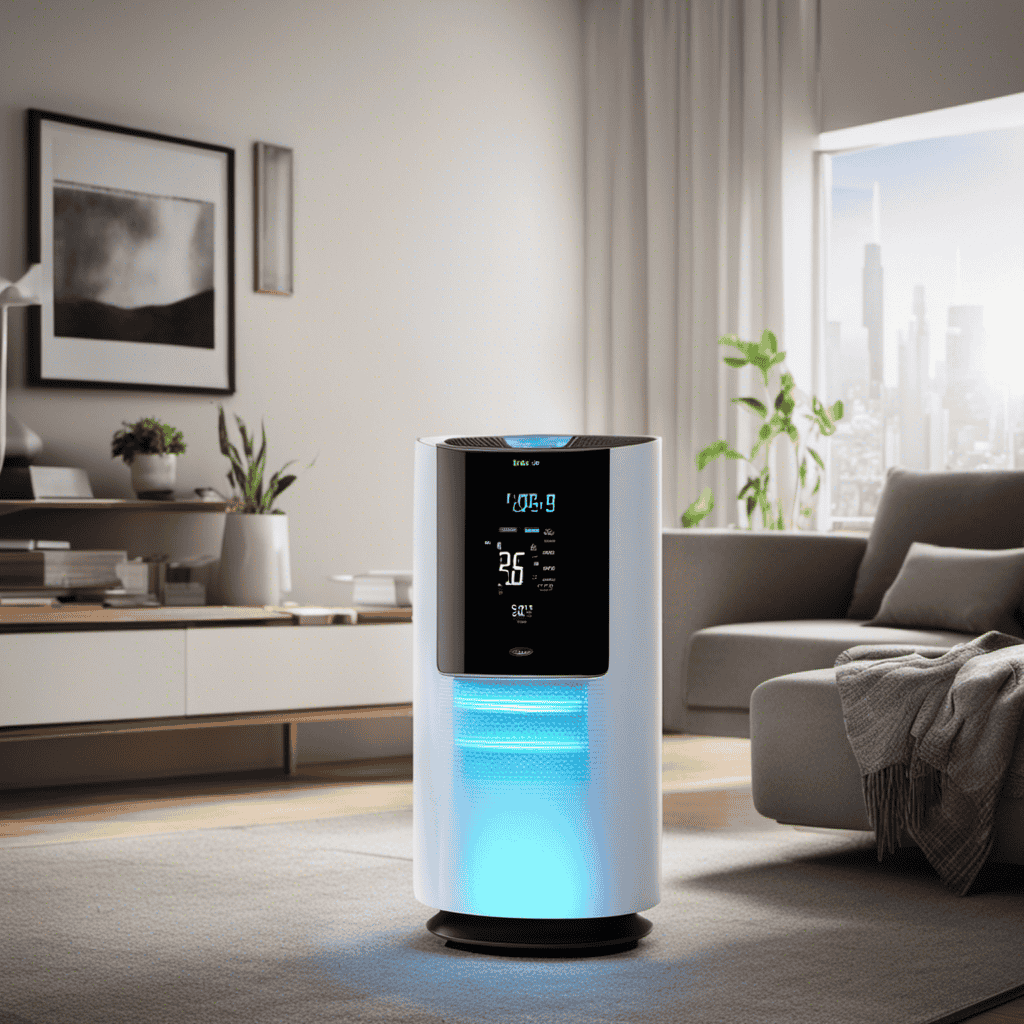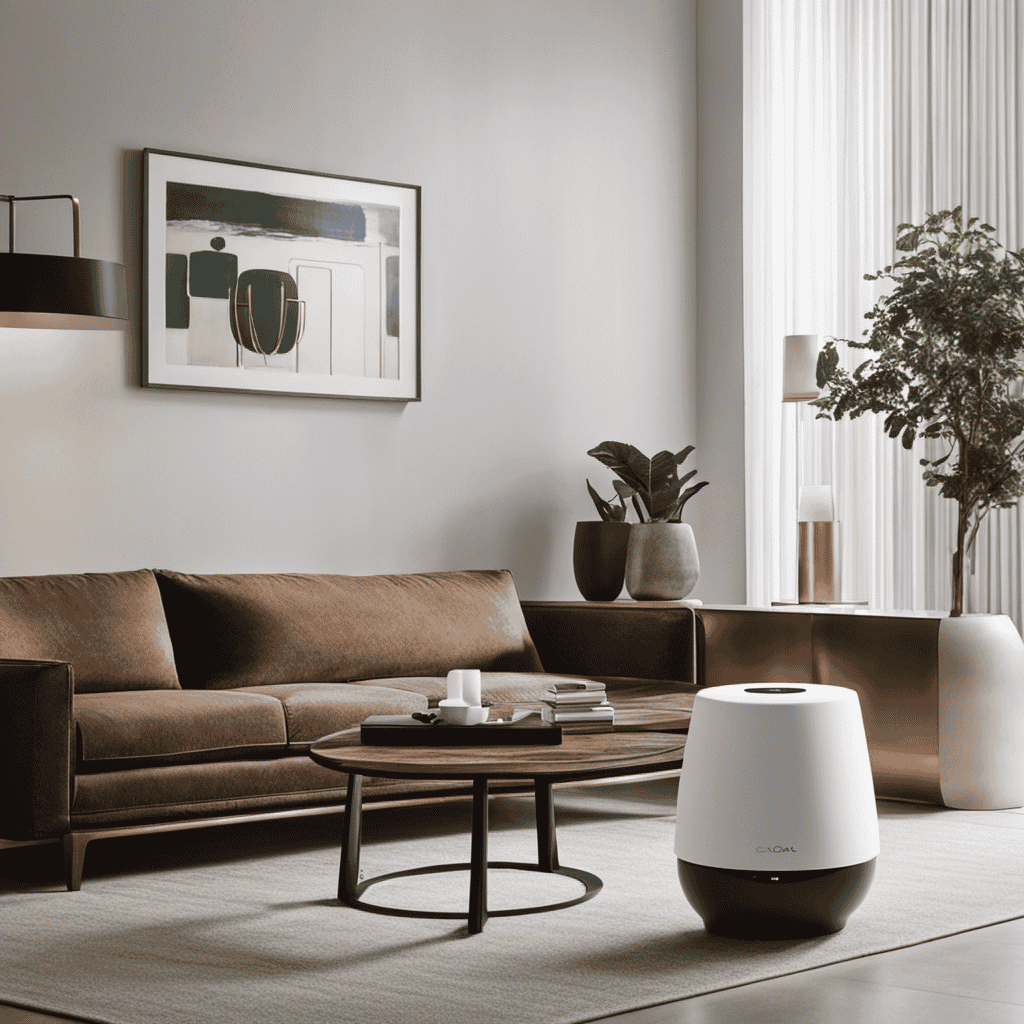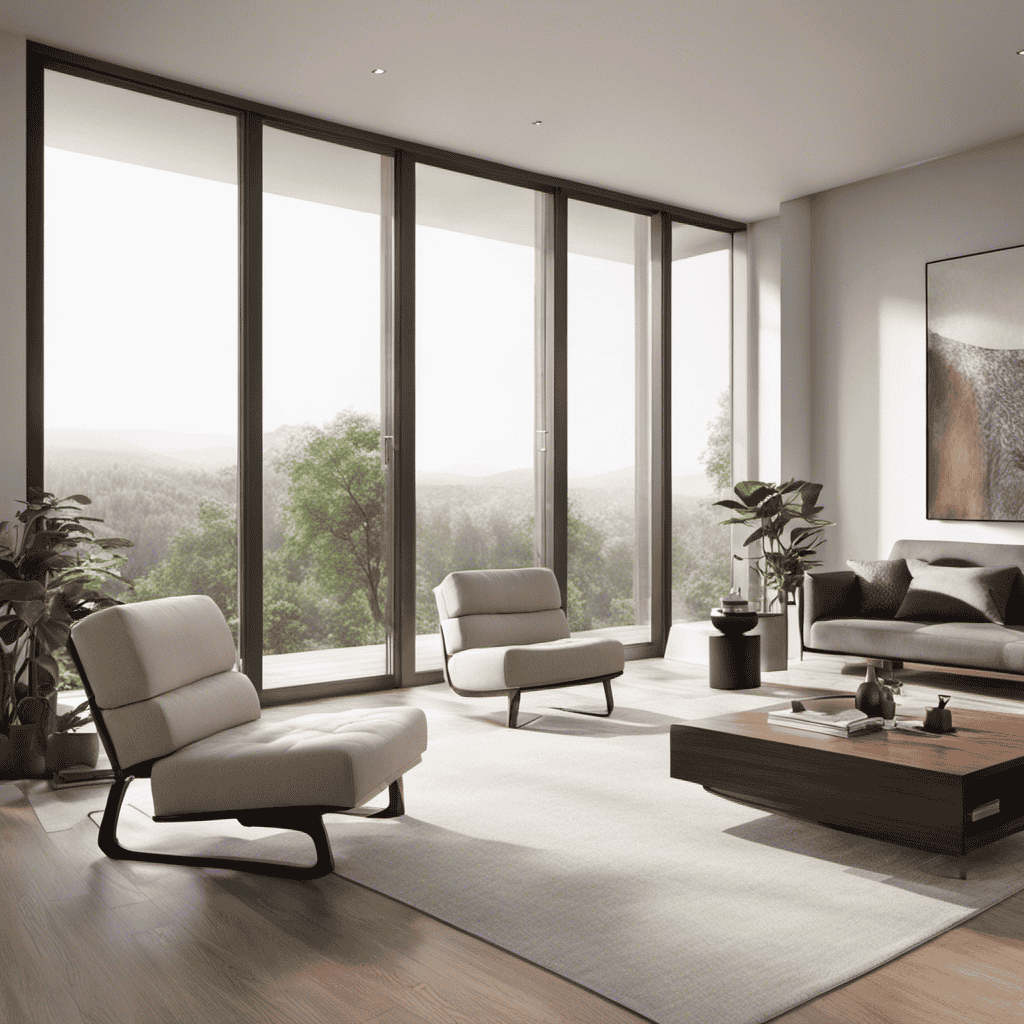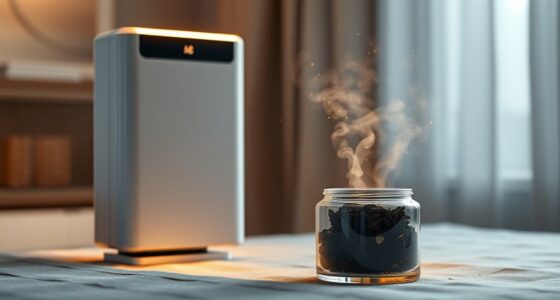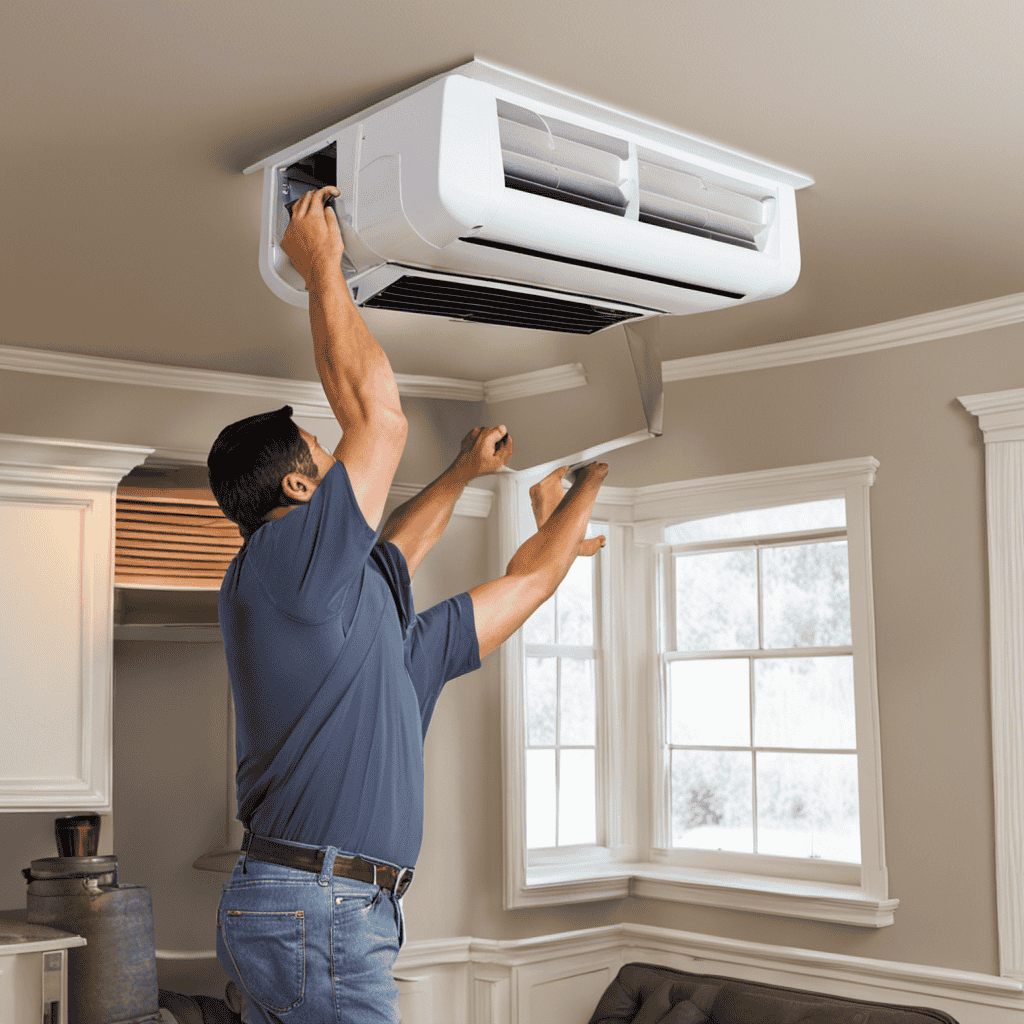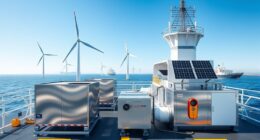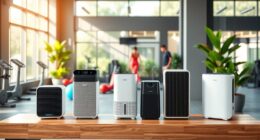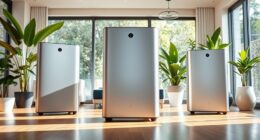Sitting in my living room, taking in the refreshing, clean air, I can’t help but ponder how much energy my air purifier is using. With the growing focus on energy efficiency, it’s important to comprehend the effect of these devices on our electricity consumption.
In this article, we will delve into the intricate world of air purifiers and explore the factors that affect their energy consumption. By the end, you’ll have a clearer picture of just how much energy these marvels of technology truly use.
Key Takeaways
- Size and power of the air purifier influence energy usage
- Energy-saving features and technologies can reduce energy consumption
- Understanding energy efficiency ratings can help choose a more energy-efficient air purifier
- Factors such as room size, power rating, fan speed, and duration of usage affect electricity consumption
Energy Consumption of Air Purifiers
Air purifiers typically use a significant amount of energy to operate efficiently. The energy consumption of air purifiers can be influenced by several factors.
Firstly, the size and power of the air purifier play a role in determining its energy usage. Larger and more powerful models tend to consume more energy.
Additionally, the type of filtration system used by the air purifier can impact energy consumption. HEPA filters, for example, are highly effective at removing particles from the air but require more energy to operate.
Furthermore, the air quality of the environment being purified can also affect energy usage. If the air is heavily polluted, the air purifier may need to work harder and consume more energy.
It is important to consider the impact of air purifiers on the environment due to their energy consumption. Manufacturers should strive to develop energy-efficient models to minimize the environmental footprint of these devices.
Factors Affecting Energy Usage in Air Purifiers
When choosing an air purifier, you’ll want to consider the factors that affect its energy usage.
Energy saving technologies and energy usage monitoring are two important aspects to consider. Energy saving technologies, such as low-power mode and sleep mode, can significantly reduce the energy consumption of an air purifier. These technologies automatically adjust the power settings based on the air quality and occupancy level in the room, ensuring efficient operation.
Energy usage monitoring, on the other hand, allows you to track and analyze the energy consumption of your air purifier. This data-driven approach can help you identify patterns and make informed decisions to optimize energy usage.
Understanding Energy Efficiency Ratings for Air Purifiers
Understanding the energy efficiency ratings for air purifiers can help you make an informed decision when choosing the right one for your needs.
Energy efficient air purifiers are equipped with advanced technologies that optimize energy usage while maintaining effective air purification. These technologies include energy saving features such as low power consumption motors, efficient filtration systems, and intelligent sensors that adjust fan speeds based on air quality.
The energy efficiency rating of an air purifier is typically indicated by the Energy Star label, which signifies compliance with strict energy efficiency guidelines set by the Environmental Protection Agency (EPA).
By selecting an air purifier with a higher energy efficiency rating, you can reduce your energy consumption and contribute to a more sustainable environment.
It’s important to consider not only the air purifier’s performance but also its energy-saving technology when making your decision.
How Much Electricity Does an Air Purifier Consume
When comparing energy consumption of air purifiers, it’s important to consider various factors that can affect electricity usage.
These factors include:
- The size of the room
- The air purifier’s power rating
- The fan speed setting
- The duration of usage
Energy Consumption Comparison
The energy consumption of air purifiers can vary widely, so it’s important to compare different models before making a decision.
When looking for energy saving innovations and cost effective solutions, it is crucial to consider the wattage of the air purifier and its efficiency rating. Higher wattage generally means higher energy consumption, so opting for a model with lower wattage can help save energy and reduce electricity costs.
Additionally, some air purifiers come with energy-saving features such as automatic shut-off timers and sleep modes, which can further reduce energy usage.
It is also essential to look for air purifiers with energy-efficient filters that can effectively remove pollutants while minimizing energy consumption.
Factors Affecting Electricity Usage
One important factor to consider is the wattage of different air purifier models and how it affects electricity usage. When choosing an air purifier, it’s essential to opt for a model with lower wattage to minimize energy consumption.
Here are some energy-saving tips to keep in mind:
- Look for air purifiers with energy-efficient certifications, such as Energy Star.
- Consider models with adjustable fan speeds, allowing you to reduce energy usage when air quality is good.
- Opt for air purifiers with timers or programmable settings to automatically turn off when not needed.
- Choose air purifiers with washable or reusable filters to reduce waste and save on replacement costs.
Comparing Energy Usage of Different Air Purifier Models
To compare energy usage of different air purifier models, you should look at the wattage listed on the product labels. This information is crucial when considering energy saving tips and air purifier maintenance.
The wattage indicates the amount of power consumed by the air purifier during operation. Lower wattage means the appliance uses less energy, which results in lower electricity bills.
When comparing models, it is important to consider the size of the room and the desired level of air purification. Larger rooms may require air purifiers with higher wattage to effectively clean the air.
Additionally, certain features such as fan speed settings and filter types can also affect energy usage.
Tips to Reduce Energy Consumption of Your Air Purifier
When it comes to air purifiers, energy-saving options and efficient filtration methods are crucial in reducing energy consumption and improving indoor air quality.
Energy-saving air purifiers employ advanced technologies such as low-power motors, energy-efficient fans, and intelligent sensors to optimize performance while minimizing energy usage.
Additionally, efficient filtration methods, such as HEPA filters and activated carbon filters, effectively capture and remove airborne pollutants, ensuring clean and fresh air without compromising energy efficiency.
Energy-Saving Air Purifiers
Did you know that there are energy-saving air purifiers available that can help you lower your electricity consumption? These efficient air purifiers utilize advanced energy-saving technology to minimize their energy usage without compromising their air cleaning capabilities.
Here are four key features of these energy-saving air purifiers:
-
Low power consumption: Energy-efficient air purifiers are designed to operate using minimal power, reducing their overall energy consumption compared to conventional models.
-
Smart sensors: These purifiers are equipped with smart sensors that detect the air quality and adjust the fan speed accordingly, optimizing energy usage based on the level of pollutants present.
-
Sleep mode: Energy-saving air purifiers often have a sleep mode feature that reduces noise and power consumption during the night when airflow requirements are typically lower.
-
Timer function: Some models come with a timer function that allows you to schedule the purifier to operate only when needed, further conserving energy.
Efficient Filtration Methods
With efficient filtration methods, you’ll notice a significant improvement in the quality of the air in your home. These methods not only enhance the cleanliness of the air but also contribute to reducing your carbon footprint.
By regularly maintaining and cleaning the filters of your air purifier, you can ensure its optimal performance and energy efficiency. Efficient maintenance methods include vacuuming or washing the filters, as well as replacing them according to the manufacturer’s recommendations. This helps to prevent clogged filters, which can lead to decreased airflow and increased energy consumption.
Additionally, choosing an air purifier with energy-saving features, such as programmable timers or sleep modes, can further minimize energy usage. By implementing these efficient filtration methods and reducing your carbon footprint, you can enjoy cleaner air while being environmentally conscious.
Energy-Saving Features to Look for in an Air Purifier
One important thing to consider when looking for an air purifier is the presence of energy-saving features. Not only do these features help reduce your carbon footprint, but they also save you money on your energy bill.
Here are four energy-saving technologies to look for in efficient air purifier models:
-
Smart Sensors: These sensors detect the air quality in your space and adjust the purification level accordingly, optimizing energy usage.
-
Timer Function: This feature allows you to set specific operating hours for the air purifier, ensuring it only runs when needed.
-
Sleep Mode: By reducing fan speed and noise level during nighttime hours, sleep mode saves energy while still providing clean air.
-
Energy Star Certification: Air purifiers with this certification meet strict energy efficiency guidelines, consuming less power without compromising performance.
Considering these energy-saving features will not only enhance your air quality but also have a positive impact on your energy bill.
The Impact of Air Purifiers on Your Energy Bill
Consider the impact of air purifiers on your energy bill when choosing an efficient model with energy-saving features. Energy-saving tips can help you optimize your air purifier’s performance while reducing your electricity consumption.
The impact of air purifiers on your energy bill depends on various factors, including the size of the room, the air purifier’s power consumption, and the duration of its operation. Energy-efficient air purifiers often have features such as programmable timers, sleep modes, and sensors that adjust the fan speed based on the air quality. These features help minimize energy consumption while maintaining indoor air quality.
It is essential to choose an air purifier that meets your specific needs and has a suitable CADR (Clean Air Delivery Rate) for your room size to ensure efficient operation and cost savings on your energy bill.
Does Air Purifier Size Affect Energy Usage
When it comes to air purifiers, the size of the unit can have an impact on its energy usage. Here are some key points to consider:
-
Air purifier size efficiency: Larger air purifiers typically have more powerful motors and larger filters, which can consume more energy. However, they also have a higher capacity to clean the air in larger rooms or spaces more efficiently.
-
Optimal air purifier size: It is important to choose an air purifier that is appropriate for the size of the room or space you intend to use it in. Using an air purifier that is too small for the room may result in it running constantly and consuming more energy to try and keep up with the air purification needs.
-
Energy-saving features: Some air purifiers come with energy-saving features, such as timers or sleep modes, which can help reduce energy consumption when the air purifier is not needed or during nighttime hours.
-
Regular maintenance: Keeping your air purifier clean and replacing filters as recommended by the manufacturer can help optimize its performance and energy efficiency.
Understanding the relationship between air purifier size and energy usage is important in selecting the right unit for your needs. Now, let’s explore the energy usage of air purifiers in different settings.
Energy Usage of Air Purifiers in Different Settings
In different settings, the size of an air purifier can impact how efficiently it consumes energy. Larger air purifiers tend to have more powerful motors and fans, which consume more energy to clean the air effectively. However, smaller air purifiers may not be as effective in larger spaces, leading to longer operating times and increased energy consumption.
To maximize energy efficiency, consider the following tips:
-
Choose the right size: Select an air purifier that is appropriate for the room size. A smaller room may require a smaller air purifier, while larger spaces may benefit from a larger unit.
-
Use the lowest fan speed: Running the air purifier on a lower fan speed can help reduce energy consumption. This is especially effective when the air quality is already relatively good.
-
Maintain and clean regularly: Keeping the air purifier clean and well-maintained ensures optimal performance. Follow the manufacturer’s instructions for filter replacement and regular cleaning to improve energy efficiency.
Energy Consumption of Air Purifiers Vs. Other Appliances
When considering air purifier efficiency and comparative energy consumption, it’s important to analyze the data objectively. By assessing the energy usage of air purifiers in different settings and comparing it to other appliances, we can gain valuable insights into their environmental impact.
This analysis will provide us with a comprehensive understanding of the energy efficiency of air purifiers and help us make informed decisions regarding their usage.
Air Purifier Efficiency
You can determine the efficiency of an air purifier by looking at its energy usage. Here are four key factors to consider when evaluating the power usage and reducing energy consumption of an air purifier:
-
Energy Star Certification: Look for air purifiers that have been certified by Energy Star. These models meet strict energy efficiency guidelines and can help you save on electricity bills.
-
Power Consumption: Check the wattage of the air purifier. Lower wattage means lower energy consumption, so opt for models with lower power ratings.
-
Adjustable Settings: Choose an air purifier that allows you to adjust the fan speed and power settings. Running the device on lower settings not only reduces energy usage but also extends the lifespan of the filters.
-
Smart Features: Consider air purifiers with smart features like timers and sensors. These features help optimize energy usage by automatically adjusting the purifier’s operation based on air quality and occupancy.
Comparative Energy Consumption
By comparing the power usage, you can determine which air purifier consumes less energy. Energy efficiency is an important factor to consider when selecting an air purifier, as it not only helps reduce environmental impact but also saves on electricity costs.
To compare energy efficiency, you can look at the wattage rating of different air purifiers. A lower wattage indicates a more energy-efficient device. Another way to compare energy consumption is by examining the Energy Star rating. Air purifiers with the Energy Star label are certified to meet strict energy efficiency guidelines set by the Environmental Protection Agency.
Additionally, some air purifiers come with energy-saving features such as programmable timers that allow you to control the operating hours and reduce power consumption.
Is the Energy Usage of an Air Purifier Impacting Its Electricity Consumption?
The electricity usage of air purifiers can impact its overall energy consumption. It’s important to consider the wattage and runtime of the purifier to calculate its energy usage. Energy-efficient models and using the purifier only when necessary can help minimize its electricity consumption.
Frequently Asked Questions
Are There Any Government Regulations or Standards in Place for the Energy Consumption of Air Purifiers?
Yes, there are government regulations and energy standards in place for air purifiers. These standards ensure that air purifiers meet specific energy consumption requirements, promoting energy efficiency and reducing environmental impact.
Can Using an Air Purifier Continuously for Long Periods of Time Lead to Higher Energy Usage?
Using an air purifier continuously for long periods of time can lead to higher energy usage. The energy efficiency of air purifiers can vary, impacting electricity bills. It is important to consider this when deciding on usage patterns.
Is There a Significant Difference in Energy Consumption Between Air Purifiers With Different Types of Filtration Systems?
There may be significant differences in energy consumption among air purifiers with different filtration systems. Some air purifiers may have higher air purifier efficiency, resulting in energy-saving benefits.
Can Using an Air Purifier in a Larger Room or Open Space Result in Higher Energy Usage?
Using an air purifier in a larger room or open space can result in higher energy usage due to the need for increased airflow. Additionally, the settings of the air purifier, such as fan speed, can impact energy consumption.
Are There Any External Factors, Such as Temperature or Humidity, That Can Affect the Energy Consumption of an Air Purifier?
Temperature and humidity levels can affect an air purifier’s energy consumption. Higher temperatures may require the device to work harder to maintain air quality, leading to increased energy usage. Similarly, high humidity can impact the efficiency of the purifier’s filters, also affecting energy consumption.
Conclusion
In conclusion, it’s evident that the energy consumption of air purifiers can vary based on various factors such as the model, settings, and size.
Understanding the energy efficiency ratings can help in making informed decisions when purchasing an air purifier.
While air purifiers do consume electricity, their impact on your energy bill can be minimal compared to other appliances.
It’s crucial to consider the energy usage of air purifiers in different settings to optimize their efficiency.
Overall, air purifiers offer a valuable solution for improving indoor air quality while keeping energy consumption under control.
